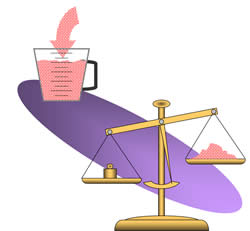Comparing Blender Technologies; Volumetric vs. Gravimetric

Although blender technology was originally developed to using volumetric principles, in recent years, higher precision gravimetric blenders have emerged as superior, simpler to use, with more model available and comparable in cost to lower accuracy volumetric models. Comparisons between the two are:
Operation:
Volumetric units control metering devices by time only, with a presumption that the metering device has been manually calibrated to relate the volume of material metered to the time the dosing device is operating. Once calibrated, the dosing device is presumed to deliver a relatively consistent volume of material per second.
Gravimetric (batch) blenders also meter based on time. However every dispense cycle is verified by weighing the dose and the control system is designed to ‘self-correct’ on subsequent doses, based on the weighed results. This self-correcting operation makes no presumption on accuracy, but actually measures the metering results and adjusts as needed for very high accuracy.
Set-up for Operation:
Volumetric blender controls are basically a series of timers and sensors designed to make presumptions of metering quantity (loosely related to material weight) and the user sets the timers according to the necessary volume of each material desired. Primary to the function however, are the initial step(s) of calibrating the metering device(s) used, to the material being metered, by time-consuming catch and weigh exercises and charting the results. This is a critical step that requires skill and manual math to assure the timer settings inputted into the blender control will deliver the correct volume of each material based on time.
Gravimetric blenders require no calibration for set-up. Since each dose of material is weighed as a part of its normal operation, the blender automatically provides its own form of “catch and weigh” exercises as a normal part of each blending cycle. As a result, the user can directly input specific weight or even ratio percentage settings into the control with no translation into time settings. Operation, although complex inside the control, is actually significantly simpler for the user.
Accuracy:
Volumetric blenders meter by timed sequences of volume doses with a presumption that the volume of the metered material does not change significantly enough to alter the results and that the material supply will never falter or be interrupted by bridging or other common flow problems. In cases where flow is consistent and the material mass does not change and/or the need for accuracy is not crucial, a volumetric blender, once set-up correctly can deliver what could be termed a fair level of accuracy. Unfortunately, the presumption mentioned above is often trumped by unexpected material problems. Volumetric blenders need to have consistent, free-flowing materials to work at all. Any change in the flow-ability of the material drastically affects the already marginal accuracy because the screw runs for X seconds and has no clue about whether any material was delivered – let alone, how much.
Gravimetric batch blenders use weight readings to verify virtually every single metered dose of all materials, with no assumptions. If a material does not meter due to flow blockage or is momentarily altered, the gravimetric blender will accommodate in subsequent cycles to assure that the blend delivered, is done so based on the desired weight. All variations in flow, mass, time, etc. are accommodated and corrected in weigh blenders to deliver what could be called the highest practical accuracy available for an automatic blending system.



